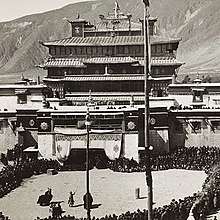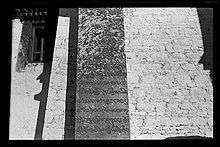Samye
Samye (Tibetan: བསམ་ཡས་, Wylie: bsam yas , Chinese: 桑耶寺) is the site of an important gompa (Buddhist monastery) in central Tibet. It is located in the Mchims phu valley, south of Lhasa, next the Hapori mountain, in the Yarlung Valley. The site is in the present administrative region of Gra Nang or Drananga Lhoka. The full name is Bsam yas mi ’gyur lhun grub gtsug lag khang, translated by some authors as the "Temple of Unchanging Spontaneous Presence."[1] Samye has a continuous history from eighth century to the present and has played an important part in the history of Tibet and China.
| Samye | |
|---|---|
བསམ་ཡས | |
 The main building of the Samye Monastery (there is a 3D model available in Google Earth) | |
| Religion | |
| Affiliation | Tibetan Buddhism |
| Sect | Nyingma and Sakya |
| Location | |
| Location | Lhasa Prefecture, Tibet Autonomous Region, China |
 Shown within Tibet | |
| Geographic coordinates | 29°19′31.80″N 91°30′13.32″E |
| Part of a series on |
| Tibetan Buddhism |
|---|
 |
|
|
|
Practices and attainment |
|
Institutional roles |
|
History and overview |
History

According to the Blue Annals, completed in 1476, the temple was constructed between 787 and 791 under the patronage of King Trisong Detsen.[2] Earlier in date is the Testament of Ba, the oldest account of the construction of the temple. This records that the foundations were laid in the 'Hare Year'. This corresponds to 763 or 775, with the completion and consecration of the main shrine taking place in the 'Sheep Year'. This is thought to correspond to 779. [3]
The plan was supposedly modeled on the design of Odantapuri in what is now Bihar, India.[4] The arrangement of the temple with a main shrine in the middle with fours shrines of different colours at the cardinal points, and the whole surrounded by a circular wall, represents the Buddhist universe as three dimensional mandala. This idea is found in a number of temples of the period in South East Asia and East Asia such as the Tōdai-ji in Japan.[5] As at the Tōdai-ji, the Samye temple is dedicated to Vairocana. A seminal text of Vairocana is the Mahavairocana Tantra, composed in India in the seventh century and translated into Chinese and Tibetan soon after.[6] The history of Samye is dealt with in this section; for the art and architectural features and their history, see below.

The Samye pillar or རྡོ་རིང་ and its inscription
There are many traditions about Samye compiled after the tenth century. One of the few documents belonging to the eighth century proper--but not carrying an actual date--is an inscription on the stone pillar (རྡོ་རིང་) preserved in front of the temple.[7] This records the building of temples at Lhasa and Brag Mar (i.e. Samye), and that the king, ministers and other nobles made solemn oaths to preserve and protect the endowments of the monastery. The term used for these endowments is 'necessities' or 'meritorious gifts' (Tib. ཡོ་བྱད་ Sanskrit deyadharma).[8]
The Samye bell inscription
A second dynastic record at Samye is on the large bronze bell in the entrance to the temple. This gives an account of the making of the bell by one of the queens of King Trisong Detsen. The text has been translated as follows: [9] "Queen Rgyal mo brtsan, mother and son, made this bell in order to worship the Three Jewels of the ten directions. And [they] pray that, by the power of that merit, Lha Btsan po Khri Srong lde brtsan, father and son, husband and wife, may be endowed with the harmony of the sixty melodious sounds, and attain supreme enlightenment."
Histories of Samye after the Dynastic Period
According to post-dynastic accounts such as the Testament of Ba and other accounts, such as that compiled by Bsod-nams-rgyal-mtshan (1312-1374), the Indian monk Śāntarakṣita made the first attempt to construct the monastery while promoting his sutra-centric version of Buddhism.[10] Finding the Samye site auspicious, he set about to build a structure there. However, the building would always collapse after reaching a certain stage. Terrified, the construction workers believed that there was a demon or obstructive tulku in a nearby river making trouble.
When Shantarakshita's contemporary Padmasambhava arrived from northern India, he was able to subdue the energetic problems obstructing the building of Samye. According to the 5th Dalai Lama,[11] Padmasambhava performed the Vajrakilaya dance and enacted the rite of namkha to assist Trisong Detsen and Śāntarakṣita clear away obscurations and hindrances in the building of Samye:
The great religious master Padmasambhava performed this dance in order to prepare the ground for the Samye Monastery and to pacify the malice of the lha [local mountain god spirits] and srin [malevolent spirits] in order to create the most perfect conditions."[12] He went on to say that after Padmasambhava consecrated the ground he erected a thread-cross — a web colored thread woven around two sticks — to catch evil. Then the purifying energy of his dance forced the malevolent spirits into a skull mounted on top of a pyramid of dough. His tantric dance cleared away all the obstacles, enabling the monastery to be built in 767. The dance was memorialized by the construction of Vajrakilaya stupas — monuments honoring the ritual kilya (purba) daggers — at the cardinal points of the monastery, where they would prevent demonic forces from entering the sacred grounds.[13])
The abovementioned quotation makes reference to the relationship of the kīla to the stupa and mentions torma and namkha. Moreover, the building of Samye marked the foundation of the original school of Tibetan Buddhism, the Nyingma. This helps explain how Padmasambhava's Tantra-centric version of Buddhism gained ascendence over the sutra-based teaching of Śāntarakṣita.
Pearlman succinctly charts the origin of the institution of the Nechung Oracle:
When Padmasambhava consecrated Samye Monastery with the Vajrakilaya dance, he tamed the local spirit protector, Pehar Gyalpo, and bound him by oath to become the head of the entire hierarchy of Buddhist protective spirits. Pehar, later known as Dorje Drakden, became the principal protector of the Dalai Lamas, manifesting through the Nechung Oracle.[14]
The Great Debate
One of the key events in the history of Samye was the debate between Buddhist schools hosted by Trisong Detsen in the 790s. Adamek (2007: p. 288) provides a circa five-year range when Moheyan of the East Mountain Teaching of Chan Buddhism and Kamalaśīla may have debated at Samye in Tibet:
As is well known, the fate of Chan in Tibet was said to have been decided in a debate at the Samye monastery.[15]
Broughton identifies the Chinese and Tibetan nomenclature of Moheyan's teachings and identifies them principally with the East Mountain Teaching:
Mo-ho-yen's teaching in Tibet as the famed proponent of the all-at-once gate can be summarized as "gazing-at-mind" ([Chinese:] k'an-hsin... [...] [Tibetan:] sems la bltas) and "no examining" ([Chinese:] pu-kuan [...] [Tibetan:] myi rtog pa) or "no-thought no-examining" ([Chinese:] pu-ssu pu-kuan... [...] [Tibetan:] myi bsam myi rtog). "Gazing-at-mind" is an original Northern (or East Mountain Dharma Gate) teaching. As will become clear, Poa-t'ang and the Northern Ch'an dovetail in the Tibetan sources. Mo-ho-yen's teaching seems typical of late Northern Ch'an. Mo-ho-yen arrived on the central Tibetan scene somewhat late in comparison to the Ch'an transmissions from Szechwan.[16]
The great debate of the Council of Lhasa between the two principal debators or dialecticians, Moheyan and Kamalaśīla is narrated and depicted in a specific cham dance once held annually at Kumbum Monastery in Qinghai.[17]
Influences
The 18th century Puning Temple built by the Qianlong Emperor of Qing China in Chengde, Hebei was modeled after Samye.
Architectural features of the monastery and their history
Samye Monastery is laid out on the shape of a giant mandala, with the main temple representing the legendary Mount Meru in the centre. Other buildings stand at the corners and cardinal points of the main temple, representing continents and other features of tantric Buddhist cosmology.
In corners are 4 chörtens - white, red, green (or blue) and black. There are 8 main temples:
- Dajor ling བརྡ་སྦྱོར་གླིང་ (brda sbyor gling)
- Dragyar ling སྒྲ་བསྒྱར་གླིང་ (sgra bsgyar gling)
- Bétsa ling བེ་ཙ་གླིང་ (be tsa gling)
- Jampa ling བྱམས་པ་གླིང་ (byams pa gling)
- Samten ling བསམ་གཏན་གླིང་ (bsam gtan gling)
- Natsok ling སྣ་ཚོགས་གླིང་ (sna tshogs gling)
- Düdül ling བདུད་འདུལ་གླིང་ (bdud 'dul gling)
- Tamdrin ling རྟ་མགྲིན་གླིང་ (rta mgrin gling)
The original buildings have long disappeared. They have been badly damaged several times — by civil war in the 11th century, fires in the mid 17th century and in 1826, an earthquake in 1816, and in the 20th century, particularly during the Cultural Revolution. As late as the late 1980s pigs and other farm animals were allowed to wander through the sacred buildings. Heinrich Harrer quoted his own words he said to the 14th Dalai Lama of what he saw in 1982 from his airplane en route to Lhasa,
"On our approach, in the Brahmaputra valley, the first terrible sight we saw confirmed all the bad news about Tibet's oldest monastery, Samye; it was totally destroyed. One can still make out the outer wall, but none of the temples or stupas survives."[18]
Each time it has been rebuilt, and today, largely due to the efforts of Choekyi Gyaltsen, 10th Panchen Lama from 1986 onward, it is again an active monastery and important pilgrimage and tourist destination.[19]
See also
Gallery
- A view of Samye from above
 The protective wall of Samye
The protective wall of Samye
Notes
- Kapstein, Matthew T. The Tibetan Assimilation of Buddhism (Oxford: Oxford University Press, 2000), 26.
- འགོས་ལོ་ཙ་བ་གཞོན་ནུ་དཔལ་. The Blue Annals (དེབ་ཐེར་སྔོན་པོ་) [Data set]. Zenodo. http://doi.org/10.5281/zenodo.834036
- Dorje (1999), 172; Pasang, Wangdu, Hildegard Diemberger, and Per K. Sørensen. Dba' Bzhed: The Royal Narrative Concerning the Bringing of the Buddha's Doctrine to Tibet(Wien: Verlag der Österreichischen Akademie der Wissenschaften, 2000), 63, note 201.
- Yeshe Tsogyal (2004). The Lotus-born: The Life Story of Padmasambhava. Rangjung Yeshe Publications. p. 290. ISBN 978-962-7341-55-0.
- Willis, Michael. "From World Religion to World Dominion: Trading, Translation and Institution-building in Tibet," in Religions and Trade Religious Formation, Transformation and Cross-Cultural Exchange between East and West, edited by Peter Wick and Volker Rabens (Leiden: Brill, 2013), 231-59. https://doi.org/10.1163/9789004255302_010
- Stephen Hodge, The Maha-Vairocana-Abhisambodhi Tantra, With Buddhaguya's Commentary (London RoutledgeCurzon, 2003).
- Hugh Richardson. A Corpus of Early Tibetan Inscriptions (London: Royal Asiatic Society, 1985), online extract at: http://doi.org/10.5281/zenodo.3564303. For text and translations, see SIDDHAM, https://siddham.network/inscription/བསམ་ཡས།-bsam-yas-pillar-inscription/
- The term is explained in Willis, Michael. " Offerings to the Triple Gem: Texts, Inscriptions and Ritual Practice," in Relics and Relic Worship in Early Buddhism, edited by Janice Stargardt (London, British Museum, 2018). Zenodo. http://doi.org/10.5281/zenodo.1249658
- Doney, Lewis. (2014). Emperor, Dharmaraja, Bodhisattva? Inscriptions from the Reign of Khri Srong lde brtsan. http://doi.org/10.5281/zenodo.3560274. Also see Hugh Richardson. A Corpus of Early Tibetan Inscriptions (London: Royal Asiatic Society, 1985).
- Sørensen, Per K. (1994). The Mirror Illuminating the Royal Genealogies: Tibetan Buddhist Historiography : An Annotated Translation of the XIVth Century Tibetan Chronicle : rGyal-rabs gsal- bai me-long. Zenodo. http://doi.org/10.5281/zenodo.3559806
- Pearlman, 2002: p.18
- Rene de Nebesky-Wojkowitz, Tibetan Religious Dances (The Hague:Mouton, 1976) p.113
- Yeshe Tsogyel, The Life and Liberation of Padmasambhava, 2 vols., trans. Kenneth Douglas and Gwendolyn Bays (Berkeley: Dharma Publishing, (1978) p.384
- Pearlman, Ellen (2002). Tibetan Sacred Dance: a journey into the religious and folk traditions. Rochester, Vermont, USA: Inner Traditions. ISBN 0-89281-918-9, p.94
- Adamek, Wendi Leigh (2007). The mystique of transmission: on an early Chan history and its contexts. Columbia University Press. ISBN 0-231-13664-1, ISBN 978-0-231-13664-8. Source: (accessed: Saturday April 17, 2010), p.288
- Jeffrey Broughton (1983). Gimello, Robert M; Gregory, Peter N (eds.). Studies in Chʻan and Hua-yen (3. print. ed.). Honolulu: University of Hawaii Press. p. 9. ISBN 978-0-8248-0835-8. Retrieved 17 October 2014.
- Roccasalvo, Joseph F (October 1980). "The debate at bsam yas: religious contrast and correspondence". Philosophy East and West. The University of Press of Hawaii. 30 (4): 505–520. doi:10.2307/1398975. JSTOR 1398975. Retrieved 17 October 2014.
- 1912-2006., Harrer, Heinrich (1985) [1984]. Return to Tibet: Tibet After the Chinese Occupation. Harmondsworth: Penguin Books. ISBN 9780140077742. OCLC 13856937.
On our approach, in the Brahmaputra valley, the first terrible sight we saw confirmed all the bad news about Tibet's oldest monastery, Samye; it was totally destroyed. One can still make out the outer wall, but none of the temples or stupas survives.
CS1 maint: numeric names: authors list (link) - Dorje (1999), p. 173.
References
- Dorje, Gyurme. (1999). Footprint Tibet Handbook with Bhutan. 2nd Edition. Footprint Handbooks Ltd. ISBN 0-8442-2190-2.
- Dowman, Keith. (1988) The Power-places of Central Tibet. Routledge & Kegan Paul. London & New York. ISBN 0-7102-1370-0.
- Rene de Nebesky-Wojkowitz, Tibetan Religious Dances (The Hague:Mouton, 1976)
- Yeshe Tsogyel, The Life and Liberation of Padmasambhava, 2 vols., trans. Kenneth Douglas and Gwendolyn Bays (Berkeley: Dharma Publishing, 1978)
- Pearlman, Ellen (2002). Tibetan Sacred Dance: a journey into the religious and folk traditions. Rochester, Vermont, USA: Inner Traditions. ISBN 0-89281-918-9
- Luke Wagner and Ben Deitle (2007). Samyé
External links
| Wikimedia Commons has media related to Samye. |
- Samye Monastery - Sacred Destinations
- Samye - by Travel China guide